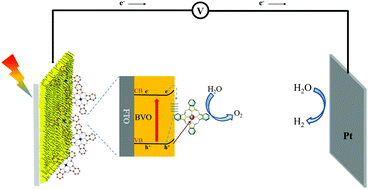Construction of organic–inorganic hybrid photoanodes with metal phthalocyanine complexes to improve photoelectrochemical water splitting performance†
Abstract
The efficiency of photoanodes is the bottleneck of photoelectrochemical (PEC) water splitting. It is of great significance to develop low-cost and efficient photoanode materials. In this study, low-cost metal phthalocyanine complexes (MPcs) have been modified on the BVO surface as a novel molecular cocatalyst to construct a highly efficient organic–inorganic hybrid photoanode. Compared with the pristine BVO photoanode, the BVO/CoPc hybrid photoanode showed a ∼2.5 times enhancement with 3.23 mA cm−2 at 1.23 VRHE. Moreover, the potential at 0.5 mA cm−2 was shifted negatively by 310 mV after the modification of CoPc. Further characterizations and electrochemical analysis results showed that CoPc could significantly promote the migration of charge carriers and accelerate the kinetics of water oxidation, thus improving the PEC performance of the hybrid photoanodes. This work of the organic–inorganic hybrid photoanode provides a new route for the design of low-cost, highly efficient PEC devices.



 Please wait while we load your content...
Please wait while we load your content...